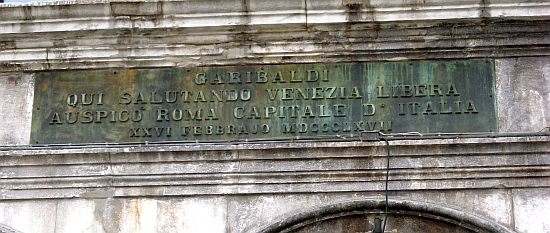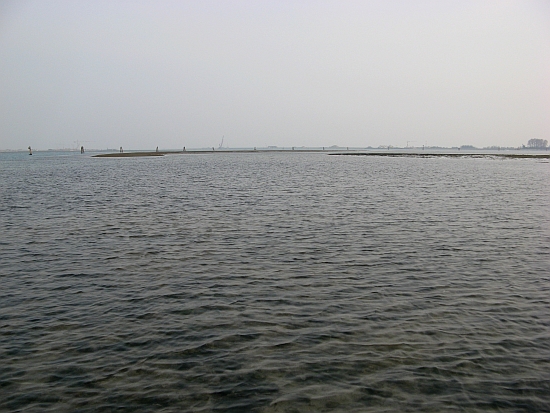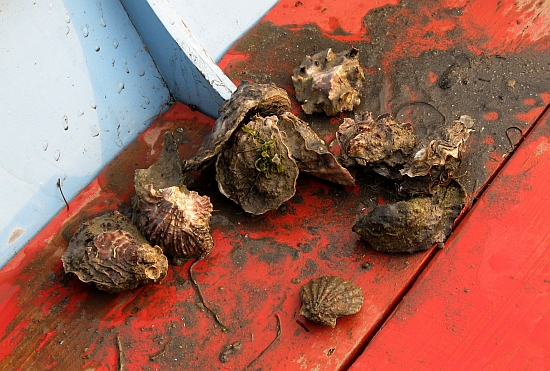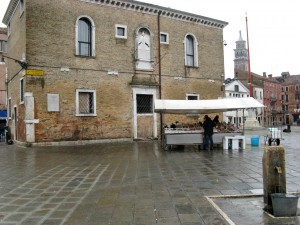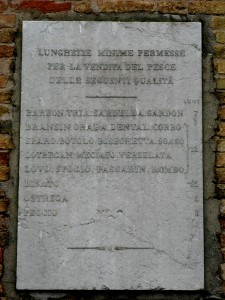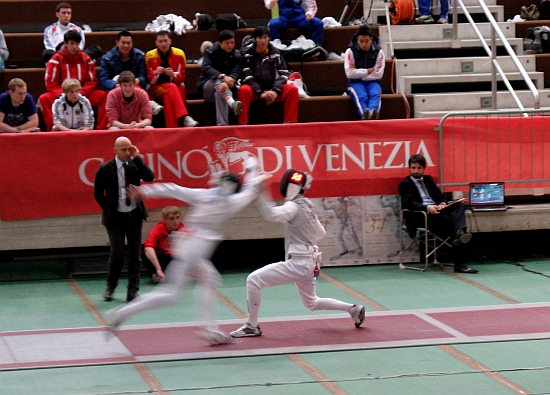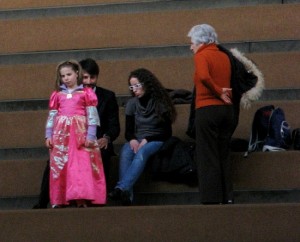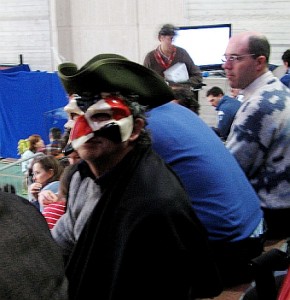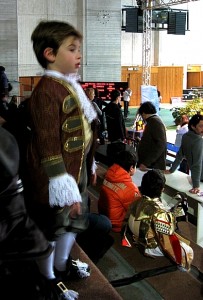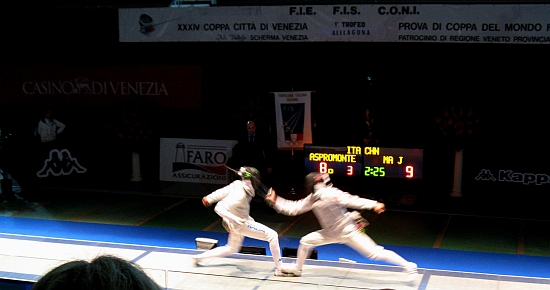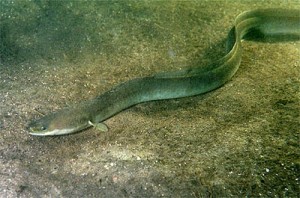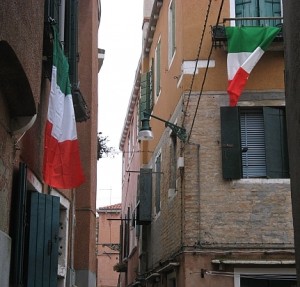
Today, March 17, there is cause for rejoicing in the old Bel Paese. In fact, it’s a national holiday. Some political parties have been bickering — you know how they love to bicker –about exactly how much joy is justifiable, but I think most of their shenanigans are going to be drowned out. It’s just too big a deal.
What? One hundred and fifty years ago today — March 17, 1861 — Italy was born. The process of labor had lasted 41 years (120 years, if you count the uprising in Genoa on December 5, 1746 as the start), but here it finally was: A whole country with one name where before there had only been jostling, homicidal kingdoms, duchies, princedoms, and the occasional city-state such as Venice and the Papal States, each loaded with greed and heavy weaponry and ruled by people whose characters were so stuffed with ambition that there wasn’t much room left for scruples. Mostly.
Revolution: Italy wasn’t a country for most of history, recorded or otherwise; it became a country as the fruit of heroic and idealistic travail, a period known as the Risorgimento. This process involved not a few bloody and horrific battles, conducted by people whose names deserve to be read aloud in every public square today. Actually, every day. They believed in a unified Italy with passion and conviction (like most revolutionaries), and certainly more strongly than a lot of people today believe in anything, considering that they were willing to die for it. In fact, there were no fewer than three Wars of Independence which led ultimately to the country we associate so happily with pizza and “O’ Sole Mio” and Vinnie and Guido.
So today is known as the anniversary of the “Unita’ d’Italia,” the unity, or uniting, of Italy. Let us pause briefly for the national anthem, and I hope any of you hecklers can look these people in the face.
The National Anthem: It goes by several names : “Inno di Mameli,” “Fratelli d’Italia,” or the original title, “Canto degli Italiani.” This stirring piece of 19th-century patriotic romanticism is crammed with historic references , each of which plays a specific symbolic role. Goffredo Mameli composed this poem in 1847 at the age of 21. not long before his untimely death. The text exhorts Italians to awaken, reclaim their historic pride, and struggle till independence is achieved. Even I know the first of its five verses.
The most moving passage begins the second: “For centuries we’ve been trampled and derided, because we’re not a people, because we’re divided. Let us all gather under one flag, one hope, to fuse ourselves together….” The term is the same one used for producing alloys of metal.
The Great Men: The struggle for independence was led by the even-then-legendary General Giuseppe Garibaldi and his noted partner, General Nino Bixio, and many other patriots, particularly Mazzini and Cavour.

And what founding a nation be without certain mythic phrases? Every child learns them and they become part of the common vocabulary, even if you don’t use them. More or less like I cannot tell a lie.”
Garibaldi, at a certain crucial point in the struggle, is supposed to have turned to Bixio and declared, “Nino, qui si fa l’Italia, o si muore” (Here one creates Italy, or dies). He probably didn’t say that, scholars point out; the rallying cry that is documented also has a certain ring to it: “Italia qui bisogna morire!” (“Italy, here we need to die,” the sense being the need to make a desperate assault, once and for all, without thinking of survival).
There is also his equally famous reply to King Vittorio Emanuele II of Savoia, who commanded him to halt his imminently victorious advance on Trento: “Obbedisco,” said Garibaldi. “I obey.” It’s hard for me to come up with a one-word response so freighted with meaning, one that isn’t profane.

While these terms might not be needed every day, it’s more common to hear somebody describe a thing that’s been done, created, thrown together, really fast, as having been done “alla garibaldina” — like a soldier of Garibaldi. This isn’t to disparage a man who was universally admired, even by his enemies, for his courage and discipline, but to express how his troops had to keep improvising in order to keep going.
Unity Today? You might think that unity would be something nobody would argue with today, but you would be in error. The politicians governing some Italian regions (what correspond to our states), are all tangled up in snarly disputes about how valuable it really is to be part of one whole country with one name. (Sorry, Garibaldi, I guess all those men of yours died for nothing. Oh wait — they died so that politicians could argue later about whether what they did ever mattered. Impressive.)
The Northern League wants the northern regions to secede, for example, and when its intensely right-wing members look at the unified Italy they see only disaster and bankruptcy of every sort (financial, moral, political, etc.) where many people from beyond the borders notice only a great country with a great history and great food and great art and and great music and so on.
And speaking of music, the League doesn’t even like the national anthem. And they don’t just nag about it, some politicians have even left their city council meetings when the anthem was played. Apart from being moronic, it shows some invigorating hypocrisy. They seem to have forgotten (or dismiss) the fact that when most of them fulfilled their compulsory military service (until the draft was suspended in 2005), they swore a solemn oath to defend their country. Sounds a little strange to say later, “Oh well, we didn’t mean THAT country.” Second, they got elected to governmental bodies of some sort, which to me represents a sort of agreement to the system as organized by the Constitution. Put more crudely, they’re happy to have the gig, and now they’re going to waste time talking about how stupid it is.
What I think: While flaws and defects and even derelictions of duty may abound (this being a country populated by people and not by angels, though the gross tonnage of paintings and statues of the winged beings might make you doubt it), this is a country that deserves all the admiration usually lavished on more famous peoples and revolutions, such as the French, or the American, or the Russian. Furthermore, until a person can say “I could have done everything they did, and I’m willing to die, just tell me where to stand and what to have on,” that person would do well to take several deep breaths and change the subject, because comments from people who can’t say that matter less than a sack of dried split peas.
The Soundtrack: Like most children of his generation, Lino also learned, along with kilometers of poetry, a slew of the patriotic songs which were composed and sung during the Risorgimento. He can still sing verses and verses of them — it’s extremely cool. He vividly recalls being taken, with the rest of his class, to the Piazza San Marco on April 25, 1946 (Liberation Day). He was eight years old, and the teachers had armed everybody with little Italian flags to wave. He remembers singing “O Giovani Ardenti,” among various pieces, and as you’ll see below, it practically sings itself.
I’d love to translate all of these songs for you, but I suspect you can interpret the main words, which are the ones you’d expect in songs such as these (independent, liberty, union, battle, sword, slave, and so on). “Camicia Rossa” refers to the emblematic red shirt worn by Garibaldi’s soldiers; “Suona la Tromba” is a call-to-arms rally, and “La Bandiera dei Tre Colori” (or “La Bandiera Tricolore“) is plainly about the flag, the most beautiful in the world.
So a big shout-out to all my Italian friends in the US, of whatever generation they may be: Camilla, Bill, Ben, Francesca, and Nicolo’. I hope you’re proud as all get-out. I am.
Next: The celebrations.

